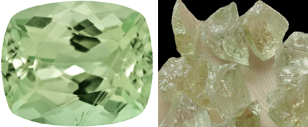 Photo of Amblygonite in Processed & Rough Form
Photo of Amblygonite in Processed & Rough Form
Amblygonite is a mineral with a hardness of 6 out of 10 on the Mohs scale of mineral hardness [?]. These Triclinicly structured gems are made of lithium aluminum hydroxyphosphate, their full chemical compound being LiAl(F,OH)PO4.
Amblygonite is a not so popular gem whose greek name means crooked. It comes in green, clear, yellow, and even purple. Older cut specimens may have slightly rounded facet edges due to the gems lack hardness (6 of 10).
Amblygonite can be found in Brazil, France, the United States, Burma, and even Sweden. It may be confused easily with Brazilianite.
The specific gravity [?] for Amblygonite is 3.02, it's refractive index [?] is 1.57-1.60, and it's double refraction [?] is 0.026.
History
It was first found and noted in 1817 and named from the Greek amblus meaning crooked.
Industrial Usages
We are unaware of any industrial usages of Amblygonite at the moment.





